Syntheses, Properties, and Applications of ZnS-Based Nanomaterials
Abstract
:1. Introduction
2. Syntheses of ZnS Nanomaterials
2.1. Zero-Dimensional ZnS
2.2. One-Dimensional ZnS
2.3. Two-Dimensional ZnS
2.4. Three-Dimensional ZnS
3. Properties and Applications
| ZnS Nanostructure | Application | Reference Number(s) |
|---|---|---|
| 0D, 1D, 2D, 3D | Biomedical/Biotechnology | [45,54,69,88] |
| 0D, 1D, 3D | Catalyst | [29,48,54,66,72,73] |
| 0D, 1D, 2D | Electroluminescence | [28,34,48,56] |
| 1D | Electronics | [50,56] |
| 2D | Infrared devices | [56] |
| 0D, 1D, 2D | Nanodevices/Nanoelectronics | [20,48,50,52,54,61,62,63] |
| 0D | Optical | [13,18,29,30,31] |
| 0D, 1D, 2D, 3D | Optoelectronic devices | [15,18,28,29,31,33,54,59,62,63,73] |
| 0D | Photovoltaic/Photoconductor | [15,29,31] |
| 0D, 1D, 2D | Sensors | [18,28,29,30,31,34,56,59,62] |
| 3D | Water and air treatment | [67,68,69,71] |
4. Conclusions
Author Contributions
Funding
Conflicts of Interest
References
- Nanotechnology Publications (Article). Available online: https://statnano.com/report/s29 (accessed on 8 April 2024).
- Davidson, W.L. X-ray diffraction evidence for ZnS formation in zinc activated rubber vulcanizates. Phys Rev. 1948, 74, 116–117. [Google Scholar]
- Garlick, F.J.; Gibson, A.F. The Luminescence of Photo-Conducting Phosphors. J. Opt. Soc. Am. 1949, 39, 935–941. [Google Scholar] [CrossRef] [PubMed]
- Yanagida, S.; Yoshiya, M.; Shiragami, T.; Pac, C.; Mori, H.; Fujita, H. Semiconductor photocatalysis. I. Quantitative photoreduction of aliphatic ketones to alcohols using defect-free zinc sulfide quantum crystallites. J. Phys. Chem. 1990, 94, 3104–3111. [Google Scholar] [CrossRef]
- Work, L.; Odell, H. Mechanism of Development of Pigment Value in Zinc Sulfide. I. Theory of Development of Pigment Value and Methods of Test. Ind. Eng. Chem. 1933, 25, 411–416. [Google Scholar] [CrossRef]
- Mekuye, B.; Abera, B. Nanomaterials: An overview of synthesis, classification, characterization, and applications. Nano Sel. 2023, 4, 486–501. [Google Scholar] [CrossRef]
- Li, H.; Li, M.; Shih, W.; Lelkes, P.I.; Shih, W.-H. Cytotoxicity Tests of Water Soluble ZnS and CdS Quantum Dots. J. Nanosci. Nanotechnol. 2011, 11, 3543–3551. [Google Scholar] [CrossRef]
- Fang, X.; Zhai, T.; Gautam, U.K.; Li, L.; Wu, L.; Bando, Y.; Golberg, D. ZnS nanostructures: From synthesis to applications. Prog. Mater. Sci. 2011, 56, 175–287. [Google Scholar] [CrossRef]
- Xiao, W.-Z.; Wang, L.-L.; Rong, Q.-Y.; Xiao, G.; Meng, B. Magnetism in undoped ZnS studied from density functional theory. J. Appl. Phys. 2014, 115, 213905. [Google Scholar] [CrossRef]
- Azpiroz, J.M.; Lopez, X.; Ugalde, J.M.; Infante, I. Modeling Surface Passivation of ZnS Quantum Dots. J. Phys. Chem. C 2012, 116, 2740–2750. [Google Scholar] [CrossRef]
- Bae, W.; Mehra, R.K. Cysteine-capped ZnS nanocrystallites: Preparation and Characterization. J. Inorg. Biochem. 1998, 70, 125–135. [Google Scholar] [CrossRef]
- Kho, R.; Torres-Martínez, C.L.; Mehra, R.K. A Simple Colloidal Synthesis for Gram-Quantity Production of Water-Soluble ZnS Nanocrystal Powders. J. Colloid Interface Sci. 2000, 227, 561–566. [Google Scholar] [CrossRef]
- Lau, B.L.T.; Hsu-Kim, H. Precipitation and Growth of Zinc Sulfide Nanoparticles in the Presence of Thiol-Containing Natural Organic Ligands. Environ. Sci. Technol. 2008, 42, 7236–7241. [Google Scholar] [CrossRef] [PubMed]
- Nakaoka, Y.; Nosaka, Y. Electron Spin Resonance Study of Radicals Produced by Photoirradiation on Quantized and Bulk ZnS Particles. Langmuir 1997, 13, 708–713. [Google Scholar] [CrossRef]
- Nanda, J.; Sapra, S.; Sarma, D.; Chandrasekharan, N.; Hodes, G. Size-Selected Zinc Sulfide Nanocrystallites: Synthesis, Structure, and Optical Studies. Chem. Mater. 2000, 12, 1018–1024. [Google Scholar] [CrossRef]
- Vogel, W.; Borse, P.H.; Deshmukh, N.; Kulkarni, S.K. Structure and Stability of Monodisperse 1.4-nm ZnS Particles Stabilized by Mercaptoethanol. Langmuir 2000, 16, 2032–2037. [Google Scholar] [CrossRef]
- Ayodhya, D.; Venkatesham, M.; Kumari, A.; Mangatayaru, K.; Veerabhadram, G. Synthesis, Characterization of ZnS nanoparticles by Coprecipitation method using various capping agents—Photocatalytic activity and Kinetic study. IOSR J. Appl. Chem. 2016, 6, 1–9. [Google Scholar] [CrossRef]
- Allehyani, A.H.A.; Seoudi, R.; Said, D.A.; Lashin, A.R.; Abouelsayed, A. Synthesis, Characterization, and Size Control of Zinc Sulfide Nanoparticles Capped by Poly(ethylene glycol). J. Electron. Mater. 2015, 44, 4227–4235. [Google Scholar] [CrossRef]
- Ajibade, P.A.; Mbuyazi, T.B.; Paca, A.M. Synthesis and Crystal Structures of Bis(diallydithiocarbamato)zinc(II) and Silver(I) Complexes: Precursors for Zinc Sulfide and Silver Sulfide Nanophotocatalysts. ACS Omega 2023, 8, 24750–24760. [Google Scholar] [CrossRef]
- Zhang, H.; Chen, B.; Gilbert, B.; Banfield, J.F. Kinetically controlled formation of a novel nanoparticulate ZnS with mixed cubic and hexagonal stacking. J. Mater. Chem. 2006, 16, 249–254. [Google Scholar] [CrossRef]
- Wang, M.; Zhang, Q.; Hao, W.; Sun, Z.-X. Surface stoichiometry of zinc sulfide and its effect on the adsorption behaviors of xanthate. Chem. Cent. J. 2011, 5, 73. [Google Scholar] [CrossRef]
- Kaur, J.; Sharma, M.; Pandey, O.P. Effect of pH on size of ZnS nanoparticles and its application for dye degradation. Part. Sci. Technol. 2015, 33, 184–188. [Google Scholar] [CrossRef]
- Yin, L.; Zhang, D.; Wang, D.; Kong, X.; Huang, J.; Wang, F.; Wu, Y. Size dependent photocatalytic activity of ZnS nanostructures prepared by a facile precipitation method. Mater. Sci. Eng. B 2016, 208, 15–21. [Google Scholar] [CrossRef]
- Zhang, H.; Gilbert, B.; Huang, F.; Banfield, J.F. Water-driven structure transformation in nanoparticles at room temperature. Nature 2003, 424, 1025–1029. [Google Scholar] [CrossRef] [PubMed]
- Balantseva, E.; Berlier, G.; Camino, B.; Lessio, M.; Ferrari, A.M. Surface Properties of ZnS Nanoparticles: A Combined DFT and Experimental Study. J. Phys. Chem. C 2014, 118, 23853–23862. [Google Scholar] [CrossRef]
- Li, S.; Pradhan, N.; Wang, Y.; Peng, X. High Quality ZnSe and ZnS Nanocrystals Formed by Activating Zinc Carboxylate Precursors. Nano Lett. 2004, 4, 2261–2264. [Google Scholar] [CrossRef]
- Rath, T.; Kunert, B.; Resel, R.; Fritz-Popovski, G.; Saf, R.; Trimmel, G. Investigation of Primary Crystallite Sizes in Nanocrystalline ZnS Powders: Comparison of Microwave Assisted with Conventional Synthesis Routes. Inorg. Chem. 2008, 47, 3014–3022. [Google Scholar] [CrossRef] [PubMed]
- Ali, A.H.; Hashem, H.A.-E.; Elfalaky, A. Preparation, Properties, and Characterization of ZnS Nanoparticles. Eng. Proc. 2023, 31, 74. [Google Scholar]
- Hoa, T.T.Q.; van Vu, L.; Canh, T.D.; Long, N.N. Preparation of ZnS nanoparticles by hydrothermal method. J. Phys. Conf. Ser. 2009, 187, 012081. [Google Scholar] [CrossRef]
- Dengo, N.; Vittadini, A.; Natile, M.; Gross, S. In-Depth Study of ZnS Nanoparticle Surface Properties with a Combined Experimental and Theoretical Approach. J. Phys. Chem. C 2020, 124, 7777–7789. [Google Scholar] [CrossRef]
- John, R.; Florence, S. Optical, Structural and Morphological Studies of Bean- Like ZnS Nanostructures by Aqueous Chemical Method. Chalcogenide Lett. 2010, 7, 269–273. [Google Scholar]
- Shi, H.; Zhou, X.; Fu, X.; Gao, F.; Hu, Z. Preparation of organic fluids containing Cyanex 302-modified ZnS particles with high loading concentration and their tribological properties. Colloids Surf. A 2008, 313, 482–489. [Google Scholar] [CrossRef]
- Kumara, C.; Armstrong, B.; Lyo, I.; Lee, H.W.; Qu, J. Organic-modified ZnS nanoparticles as a high-performance lubricant additive. RSC Adv. 2023, 13, 7009–7019. [Google Scholar] [CrossRef] [PubMed]
- Arao, Y.; Hirooka, Y.; Tsuchiya, K.; Mori, Y. Structure and Photoluminescence Properties of Zinc Sulfide Nanoparticles Prepared in a Clay Suspension. J. Phys. Chem. C 2009, 113, 894–899. [Google Scholar] [CrossRef]
- Alivisatos, A.P. Semiconductor Clusters, Nanocrystals, and Quantum Dots. Science 1996, 271, 933–937. [Google Scholar] [CrossRef]
- Li, H.; Shih, W.Y.; Shih, W.-H. Highly Photoluminescent and Stable Aqueous ZnS Quantum Dots. Ind. Eng. Chem. Res. 2010, 49, 578–582. [Google Scholar] [CrossRef]
- Zhou, W.; Schwartz, D.T.; Baneyx, F. Single-Pot Biofabrication of Zinc Sulfide Immuno-Quantum Dots. J. Am. Chem. Soc. 2010, 132, 4731–4738. [Google Scholar] [CrossRef]
- Cooper, J.K.; Franco, A.M.; Gul, S.; Corrado, C.; Zhang, J.Z. Characterization of Primary Amine Capped CdSe, ZnSe, and ZnS Quantum Dots by FT-IR: Determination of Surface Bonding Interaction and Identification of Selective Desorption. Langmuir 2011, 27, 8486–8493. [Google Scholar] [CrossRef]
- Mandal, A.; Dandapat, A.; De, G. Magic sized ZnS quantum dots as a highly sensitive and selective fluorescence sensor probe for Ag+ ions. The Analyst 2012, 137, 765–772. [Google Scholar] [CrossRef]
- Lu, S.; Chen, T.; Wang, A.; Wu, Z.; Wang, Y. Lattice and optical property evolution of ultra-small ZnS quantum dots grown from a single-source precursor. Appl. Surf. Sci. 2014, 299, 116–122. [Google Scholar] [CrossRef]
- Hosseinzadeh, G.; Maghari, A.; Farniya, S.M.F.; Keihan, A.H.; Moosavi-Movahedi, A.A. Interaction of insulin with colloidal ZnS quantum dots functionalized by various surface capping agents. Mater. Sci. Eng. C 2017, 77, 836–845. [Google Scholar] [CrossRef]
- Yu, Z.; Guo, L.; Du, H.; Krauss, T.; Silcox, J. Shell Distribution on Colloidal CdSe/ZnS Quantum Dots. Nano Lett. 2005, 5, 565–570. [Google Scholar] [CrossRef] [PubMed]
- Ji, B.; Koley, S.; Slobodkin, I.; Remennik, S.; Banin, U. ZnSe/ZnS Core/Shell Quantum Dots with Superior Optical Properties through Thermodynamic Shell Growth. Nano Lett. 2020, 20, 2387–2395. [Google Scholar] [CrossRef] [PubMed]
- Hines, M.A.; Guyot-Sionnest, P. Bright UV-Blue Luminescent Colloidal ZnSe Nanocrystals. J. Phys. Chem. B 1998, 102, 3655–3657. [Google Scholar] [CrossRef]
- Khan, S.U.; Surme, S.; Eren, G.O.; Almammadov, T.; Pehlivan, Ç.; Kaya, L.; Hassnain, M.; Onal, A.; Balamur, R.; Şahin, A.; et al. Sulfide-Capped InP/ZnS Quantum Dot Nanoassemblies for a Photoactive Antibacterial Surface. ACS Appl. Nano Mater. 2024, 7, 5922–5932. [Google Scholar] [CrossRef]
- Karatum, O.; Aria, M.M.; Eren, G.O.; Yildiz, E.; Melikov, R.; Srivastava, S.B.; Surme, S.; Dogru, I.B.; Jalali, H.B.; Ulgut, B.; et al. Nanoengineering InP quantum dot-based photoactive biointerfaces for optical control of neurons. Front. Neurosci. 2021, 15, 652608. [Google Scholar] [CrossRef]
- Hu, J.; Odom, T.W.; Lieber, C.M. Chemistry and Physics in One Dimension: Synthesis and Properties of Nanowires and Nanotubes. Acc. Chem. Res. 1999, 32, 435–445. [Google Scholar] [CrossRef]
- Zhu, G.; Zhang, S.; Xu, Z.; Ma, J.; Shen, X. Ultrathin ZnS Single Crystal Nanowires: Controlled Synthesis and Room-Temperature Ferromagnetism Properties. J. Am. Chem. Soc. 2011, 133, 15605–15612. [Google Scholar] [CrossRef]
- Moore, D.F.; Ding, Y.; Wang, J.L. Crystal Orientation-Ordered ZnS Nanowire Bundles. J. Am. Chem. Soc. 2004, 126, 14372–14373. [Google Scholar] [CrossRef]
- Lin, M.; Zhang, J.; Boothroyd, C.; Foo, Y.L.; Yeadon, M.; Loh, K.P. Hollowing Mechanism of Zinc Sulfide Nanowires in Vacuum Induced by an Atomic Oxygen Beam. J. Phys. Chem. B 2004, 108, 9631–9637. [Google Scholar] [CrossRef]
- Shen, G.; Bando, Y.; Gao, Y.; Goldberg, D. Synthesis and Interface of Zinc Sulfide Sheathed Zinc-Cadmium Nanowire Heterojunctions. J. Phys. Chem. B 2006, 110, 14123–14127. [Google Scholar] [CrossRef]
- Shen, G.; Bando, Y.; Golberg, D. Carbon-Coated Single-Crystalline Zinc Sulfide Nanowires. J. Phys. Chem. B. 2006, 110, 20777–20780. [Google Scholar] [CrossRef]
- Zhu, Y.C.; Bando, Y.; Uemura, Y. ZnS-Zn Nanocables and ZnS Nanotubes. Chem. Comm. 2003, 836–837. [Google Scholar] [CrossRef]
- Zhao, Z.G.; Geng, F.X.; Cong, H.T.; Bai, J.; Cheng, H.-M. A simple solution route to controlled synthesis of ZnS submicrospheres, nanosheets and nanorods. Nanotechnology 2006, 17, 4731–4735. [Google Scholar] [CrossRef] [PubMed]
- Zhao, Q.; Hou, L.; Huang, R. Synthesis of ZnS nanorods by a surfactant-assisted soft chemistry method. Inorg. Chem. Comm. 2003, 6, 971–973. [Google Scholar] [CrossRef]
- Biswas, S.; Kar, S.; Chaudhuri, S. Optical and Magnetic Properties of Manganese-Incorporated Zinc Sulfide Nanorods Synthesized by a Solvothermal Process. J. Phys. Chem. B 2005, 109, 17523–17530. [Google Scholar] [CrossRef] [PubMed]
- Chen, Y.; Fan, Z.; Zhang, Z.; Niu, W.; Li, C.; Yang, N.; Chen, B.; Zhang, H. Two-Dimensional Metal Nanomaterials: Synthesis, Properties, and Applications. Chem. Rev. 2018, 118, 6409–6455. [Google Scholar] [CrossRef]
- Zhang, Z.; Wang, J.; Yuan, H.; Gao, Y.; Lin, D.; Song, L.; Xiang, Y.; Zhao, X.; Liu, L.; Luo, S.; et al. Low-Temperature Growth and Photoluminescence Property of ZnS Nanoribbons. J. Phys. Chem. B 2005, 109, 18352–18355. [Google Scholar] [CrossRef]
- Li, Z.; Wang, J.; Liu, B.; Liu, J. Phase Transition for Zinc Sulfide Nanosheets under High Pressure. J. Phys. Chem. C 2016, 120, 781–785. [Google Scholar] [CrossRef]
- Verma, A.; Chaudhary, P.; Singh, A.; Tripathi, R.K.; Yadav, B.C. ZnS Nanosheets in a Polyaniline Matrix as Metallopolymer Nanohybrids for Flexible and Biofriendly Photodetectors. ACS Appl. Nano Mater. 2022, 5, 4860–4874. [Google Scholar] [CrossRef]
- Zhang, Y.; Lu, F.; Wang, Z.; Wang, H.; Kong, M.; Zhu, X.; Zhang, L. ZnS Nanoparticle-Assisted Synthesis and Optical Properties of ZnS Nanotowers. Cryst. Growth Des. 2007, 7, 1459–1462. [Google Scholar] [CrossRef]
- Liang, C.; Shimizu, Y.; Sasaki, T.; Umehara, H.; Koshizaki, N. Au-Mediated Growth of Wurtzite ZnS Nanobelts, Nanosheets, and Nanorods via Thermal Evaporation. J. Phys. Chem. B 2004, 108, 9728–9733. [Google Scholar] [CrossRef]
- Ma, C.; Moore, D.; Ding, Y.; Li, J.; Wang, Z.L. Nanobelt and nanosaw structures of II-IV semiconductors. Int. J. Nanotechnol. 2004, 1, 431–451. [Google Scholar] [CrossRef]
- Li, X.; Wang, X.; Xiong, Q.; Eklund, P.C. Mechanical Properties of ZnS Nanobelts. Nano Lett. 2005, 5, 1982–1986. [Google Scholar] [CrossRef] [PubMed]
- Ates, B.; Koytepe, S.; Ulu, A.; Gurses, C.; Thakur, V.K. Chemistry, Structures, and Advanced Applications of Nanocomposites from Biorenewable Resources. Chem. Rev. 2020, 120, 9304–9362. [Google Scholar] [CrossRef]
- Gusain, R.; Kumar, N.; Opoku, F.; Poomani Govender, P.; Sinha Ray, S. MoS2 Nanosheet/ZnS Composites for the Visible-Light-Assisted Photocatalytic Degradation of Oxytetracycline. ACS Appl. Nano Mater. 2021, 4, 4721–4734. [Google Scholar] [CrossRef]
- Xaba, T. Green synthesis of ZnS nanoparticles and fabrication of ZnS-chitosan nanocomposites for the removal of Cr(VI) ion from wastewater. Green Process. Synth. 2021, 10, 374–383. [Google Scholar] [CrossRef]
- Asadi, F.; Azizi, S.N.; Chaichi, M.J. Green synthesis of fluorescent PEG-ZnS QDs encapsulated into Co-MOFs as an effective sensor for ultrasensitive detection of copper ions in tap water. Mater. Sci. Eng. C 2019, 105, 110058. [Google Scholar] [CrossRef] [PubMed]
- Wang, H.-J.; Yu, X.-H.; Wang, C.-F.; Cao, Y. Cooperative cytotoxic activity of Zn and Cu in bovine serum albumin-conjugated ZnS/CuS nano-composites in PC12 cancer cells. J. Nanopart. Res. 2013, 15, 2020. [Google Scholar] [CrossRef]
- Dutta, S.; Chatterjee, S.; Mukherjee, I.; Saha, R.; Singh, B.P. Fabrication of ZnS Hollow Spheres and RGO-ZnS Nanocomposite Using Cysteamine as Novel Sulfur Source: Photocatalytic Performance on Industrial Dyes and Effluent. Ind. Eng. Chem. Res. 2017, 56, 4768–4778. [Google Scholar] [CrossRef]
- Jawad, W.; Jader, M. Preparing and Studying the Combination of ZnS/ rGO Nano Composite by Laser Ablation Method. J. Phys. Conf. Ser. 2021, 1999, 012156. [Google Scholar] [CrossRef]
- Mahalingam, S.; Neelan, Y.D.; Bakthavatchalam, S.; Al-Humaid, L.A.; Al-Dahmash, N.D.; Santhanam, H.; Yang, T.-Y.; Hossain, N.; Park, S.H.; Kim, J. Effective Visible-Light-Driven Photocatalytic Degradation of Harmful Antibiotics Using Reduced Graphene Oxide-Zinc Sulfide-Copper Sulfide Nanocomposites as a Catalyst. ACS Omega 2023, 8, 32817–32827. [Google Scholar] [CrossRef] [PubMed]
- Yu, J.; Zhang, J.; Liu, S. Ion-Exchange Synthesis and Enhanced Visible-Light Photoactivity of CuS/ZnS Nanocomposite Hollow Spheres. J. Phys, Chem. C 2010, 114, 13642–13649. [Google Scholar] [CrossRef]
- Kafel, A.; Al-Rashid, S.N.T. Examining the impact of quantum confinement energy on the optical characteristics of zinc sulfide and gallium nitrate in the ultraviolet spectral range. Chalcogenide Lett. 2023, 20, 423–429. [Google Scholar] [CrossRef]
- Geng, B.; Ma, J.; Zhan, F. A solution phase thermal decomposition molecule precursors route to ZnS:Cu2+ nanorods and their optical properties. Mater. Chem. Phys. 2009, 113, 534–538. [Google Scholar] [CrossRef]
- Mansur, A.A.P.; Mansur, H.S.; Carvalho, S.M.; Lobato, Z.I.P.; de Fátima Leite, M.; Mansur, L.L. Fluorescent ZnS Quantum Dot—Phosphoethanolamine Nanoconjugates for Bioimaging Live Cells in Cancer Research. ACS Omega 2018, 3, 15679–15691. [Google Scholar] [CrossRef]
- Debnath, G.H.; Chakraborty, A.; Ghatak, A.; Mandal, M.; Mukherjee, P. Controlled Terbium(III) Luminescence in Zinc Sulfide Nanoparticles: An Assessment of Competitive Photophysical Processes. J. Phys. Chem. C 2015, 119, 24132–24141. [Google Scholar] [CrossRef]
- Bose, R.; Thupakula, U.; Bal, J.K.; Pradhan, N. Short-Lived, Intense and Narrow Bluish-Green Emitting Gold Zinc Sulfide Semiconducting Nanocrystals. J. Phys. Chem. C 2012, 116, 16680–16686. [Google Scholar] [CrossRef]
- Mukherjee, A.; Bhattacharyya, B.; Rajasekar, G.P.; Narayan, A.; Pandey, A. Optical Properties and Electronic Structure of Copper Zinc Sulfide Nanocrystals. J. Phys. Chem. C. 2021, 125, 17890–17896. [Google Scholar] [CrossRef]
- Srivastava, B.B.; Jana, S.; Karan, N.S.; Paria, S.; Jana, N.R.; Sarma, D.D.; Pradhan, N. Highly Luminescent Mn-Doped ZnS Nanocrystals: Gram-Scale Synthesis. J. Phys. Chem. Lett. 2010, 1, 1454–1458. [Google Scholar] [CrossRef]
- Talapin, D.V.; Lee, J.-S.; Kovalenko, M.V.; Shevchenko, E.V. Prospects of Colloidal Nanocrystals for Electronic and Optoelectronic Applications. Chem. Rev. 2010, 110, 389–458. [Google Scholar] [CrossRef]
- Feng, J.; Jiang, M.; Li, D.; Zhang, Y.; Pei, C.; Zhou, L.; Chen, Z.; Li, Y.; Li, X.; Xu, X. Top-Emission ZnSeTe/ZnSe/ZnS-Based Blue Quantum Dot Light-Emitting Diodes with Enhanced Chroma Efficiency. J. Phys. Chem. Lett. 2023, 14, 2526–2532. [Google Scholar] [CrossRef] [PubMed]
- Zhang, X.; Wang, T.; Lin, Q.; Chen, F.; Wang, L.; Du, Z. Highly efficient near-infrared light-emitting diodes based on Zn:CuInSe2/ZnS//ZnS quantum dots with double shell engineering. Opt. Express 2022, 30, 29449–29460. [Google Scholar] [CrossRef] [PubMed]
- Schubert, E.F.; Kim, J.K. Solid-state light sources getting smart. Science 2005, 308, 1274–1278. [Google Scholar] [CrossRef]
- Hasanirokh, K.; Asgari, A.; Mohammadi, S. Fabrication of a light-emitting device based on the CdS/ZnS spherical quantum dots. J. Eur. Opt. Soc.-Rapid Publ. 2021, 17, 26. [Google Scholar] [CrossRef]
- Entradas, T.J.; Cabrita, J.F.; Barrocas, B.; Nunes, M.R.; Silvestre, A.J.; Monteiro, O.C. Synthesis of titanate nanofibers co-sensitized with ZnS and Bi2S3 nanocrystallites and their application on pollutants removal. Mater. Res. Bull. 2015, 72, 20–28. [Google Scholar] [CrossRef]
- Naudin, G.; Entradas, T.; Barrocas, B.; Monteiro, O.C. Titanate Nanorods Modified with Nanocrystalline ZnS Particles and Their Photocatalytic Activity on Pollutant Removal. J. Mater. Sci. Technol. 2016, 32, 1122–1128. [Google Scholar] [CrossRef]
- Dabbous, A.; Bauer, P.; Marcucci, C.; Périé, S.; Gahlot, S.; Lombard, C.; Caillat, S.; Ravanat, J.-L.; Mouesca, J.-M.; Kodjikian, S.; et al. Hybrid CdSe/ZnS Quantum Dot—Gold Nanoparticle Composites Assembled by Click Chemistry: Toward Affordable and Efficient Redox Photocatalysts Working with Visible Light. ACS Appl. Mater. Interfaces 2023, 15, 56167–56180. [Google Scholar] [CrossRef]
- Li, D.; Zhang, H.; Xie, S.; Zhang, H.; Wang, H.; Ma, X.; Gao, D.; Qi, J.; You, F. Lattice Distortion in a Confined Structured ZnS/ZnO Heterojunction for Efficient Photocatalytic CO2 Reduction. Energy Environ. Catal. Appl. 2023, 15, 36324–36333. [Google Scholar] [CrossRef]
- Zhang, J.; Wang, Y.; Zhang, J.; Lin, Z.; Huang, F.; Yu, J. Enhanced Photocatalytic Hydrogen Production Activities of Au-Loaded ZnS Flowers. ACS Appl. Mater. Interfaces 2013, 5, 1031–1037. [Google Scholar] [CrossRef]
- Lange, T.; Reichenberger, S.; Ristig, S.; Rohe, M.; Strunk, J.; Barcikowski, S.; Schlögl, R. Zinc sulfide for photocatalysis: White angel or black sheep? Prog. Mater. Sci. 2022, 124, 100865. [Google Scholar] [CrossRef]
- Proshchenko, V.; Karanovich, A.; Dahnovsky, Y. Surface-Bulk Model for d0 Ferromagnetism in ZnS Quantum Dots and Wires. J. Phys. Chem. C. 2016, 120, 11253–11261. [Google Scholar] [CrossRef]
- Xu, J.; Zhang, W.; Fan, H.; Cheng, F.; Su, D.; Wang, G. Promoting lithium polysulfide/sulfide redox kinetics by the catalyzing of zinc sulfide for high performance lithium-sulfur battery. Nano Energy 2018, 51, 73–82. [Google Scholar] [CrossRef]
- Liu, R.; Tao, W.; Du, Y.; Wu, C.; Ye, H.; Fan, M.; Chen, S.; Chen, G.; Mao, J.; Xin, S.; et al. ZnS-Nanoparticle-Coated Carbon Cloth as an Efficient Interlayer for High-Performance Li-S Batteries. ACS Appl. Energy Mater. 2022, 5, 12408–12414. [Google Scholar] [CrossRef]
- Fan, A.; Hou, T.; Sun, X.; Xie, D.; Li, X.; Zhang, N.; Guo, J.; Jin, S.; Zhou, Y.; Cai, S.; et al. One-Pot Hydrothermal Synthesis of ZnS Nanospheres Anchored on 3D Conductive MWCNTs Networks as High-Rate and Cold-Resistant Anode Materials for Sodium-Ion Batteries. ChemElectroChem 2020, 7, 1904–1913. [Google Scholar] [CrossRef]
- Zhao, L.; Yin, J.; Lin, J.; Chen, C.; Chen, L.; Qiu, X.; Alshareef, H.N.; Zhang, W. Highly Stable ZnS Anodes for Sodium-Ion Batteries Enabled by Structure and Electrolyte Engineering. ACS Nano 2024, 18, 3763–3774. [Google Scholar] [CrossRef]
- Ummartyotin, S.; Infahsaeng, Y. A comprehensive review on ZnS: From synthesis to an approach on solar cell. Renew. Sustain. Energy Rev. 2016, 55, 17–24. [Google Scholar] [CrossRef]
- Liang, G.; Li, Y.; Feng, W.; Wang, X.; Jing, A.; Li, J.; Ma, K. Polyethyleneimine-coated quantum dots for miRNAdelivery and its enhanced suppression in HepG2 cells. Int. J. Nanomed. 2016, 11, 6079–6088. [Google Scholar] [CrossRef] [PubMed]

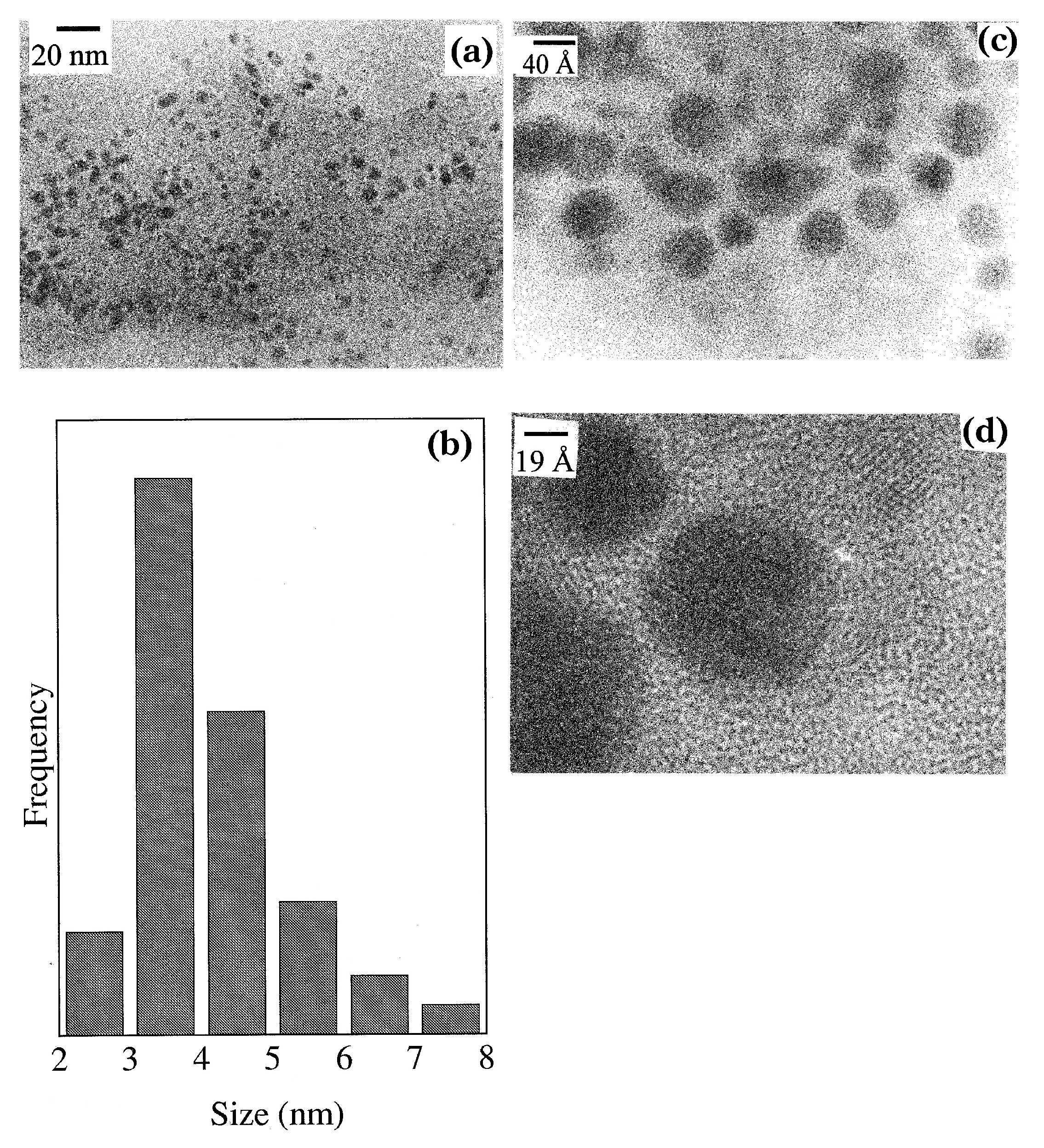
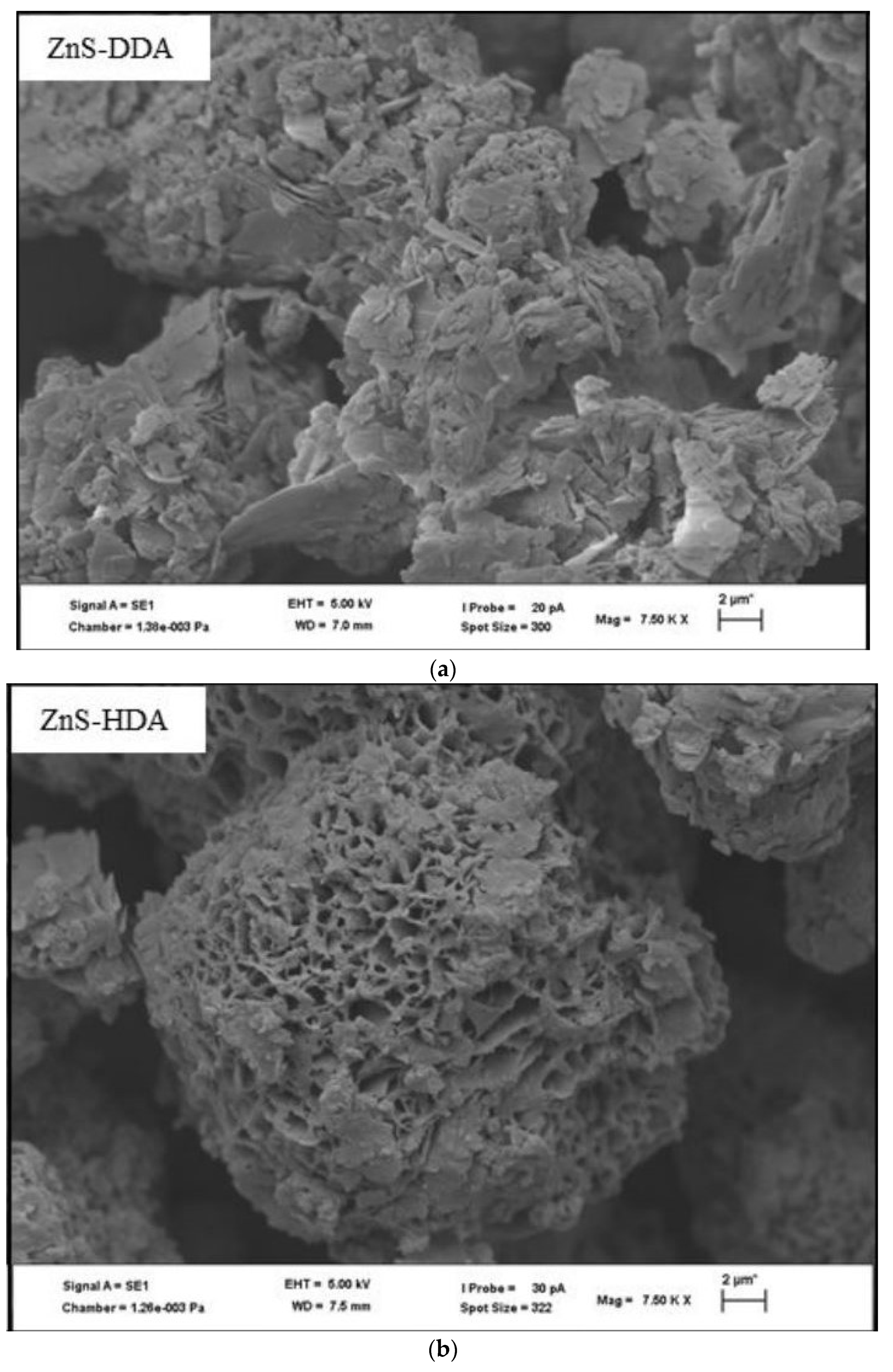
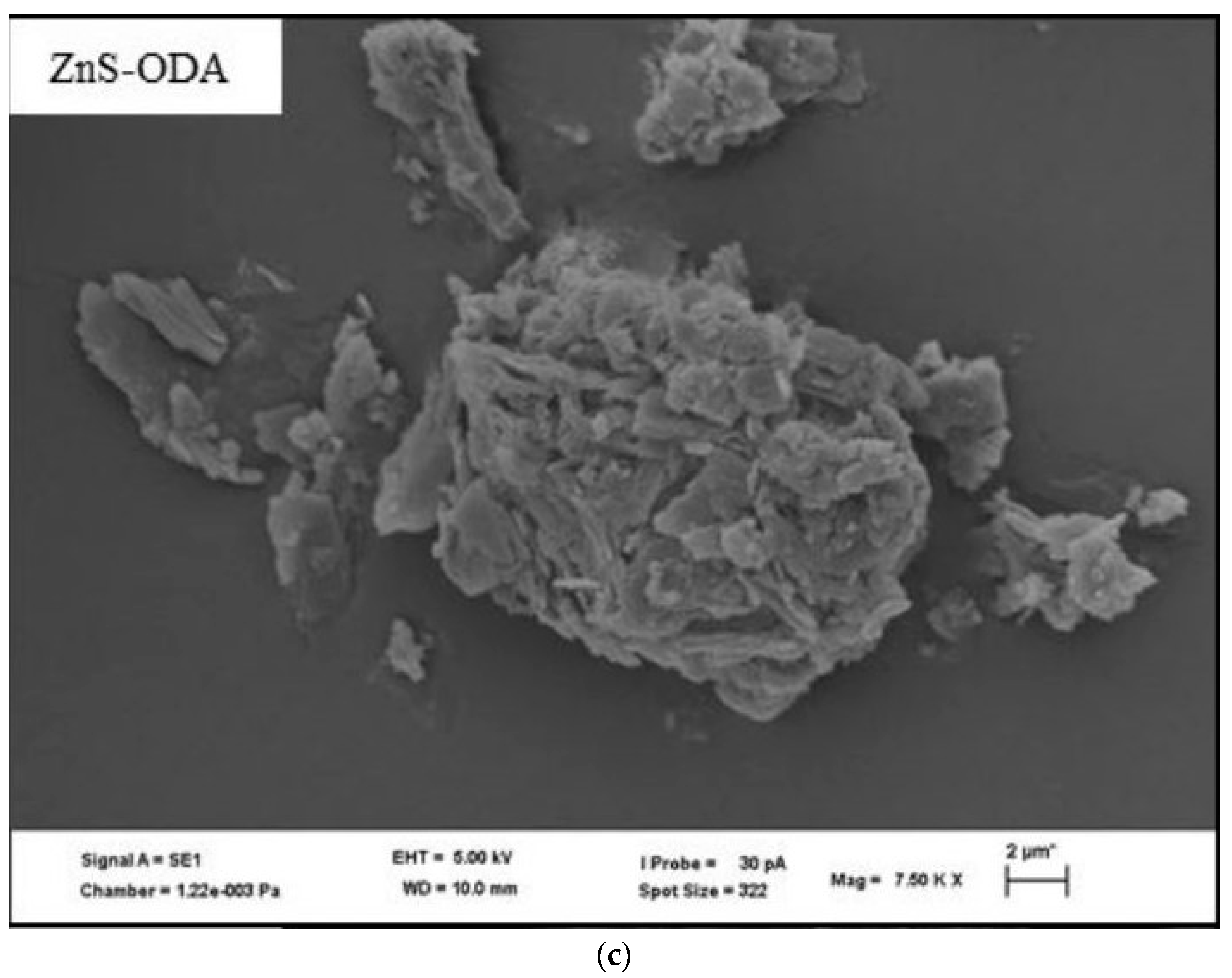
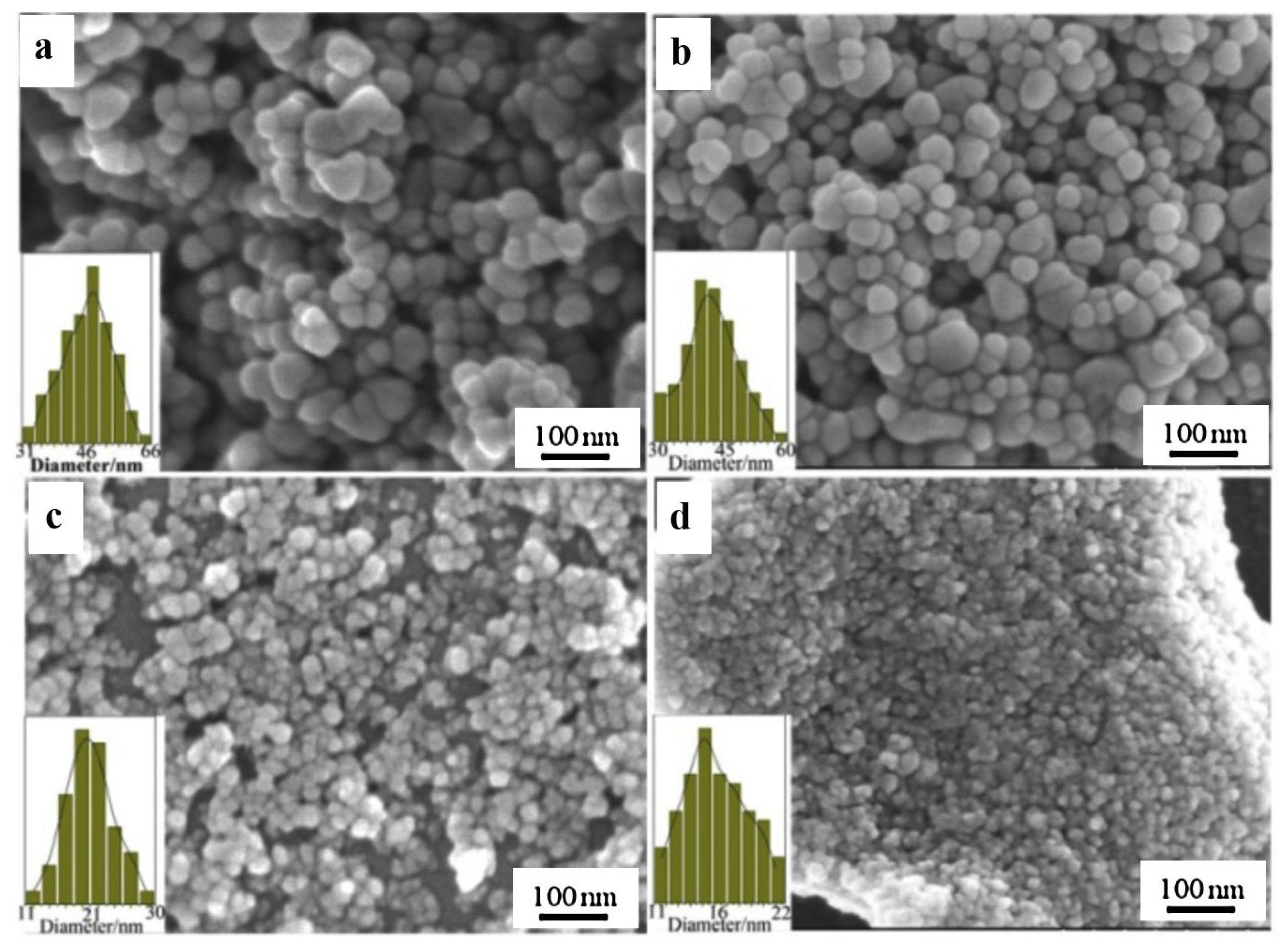
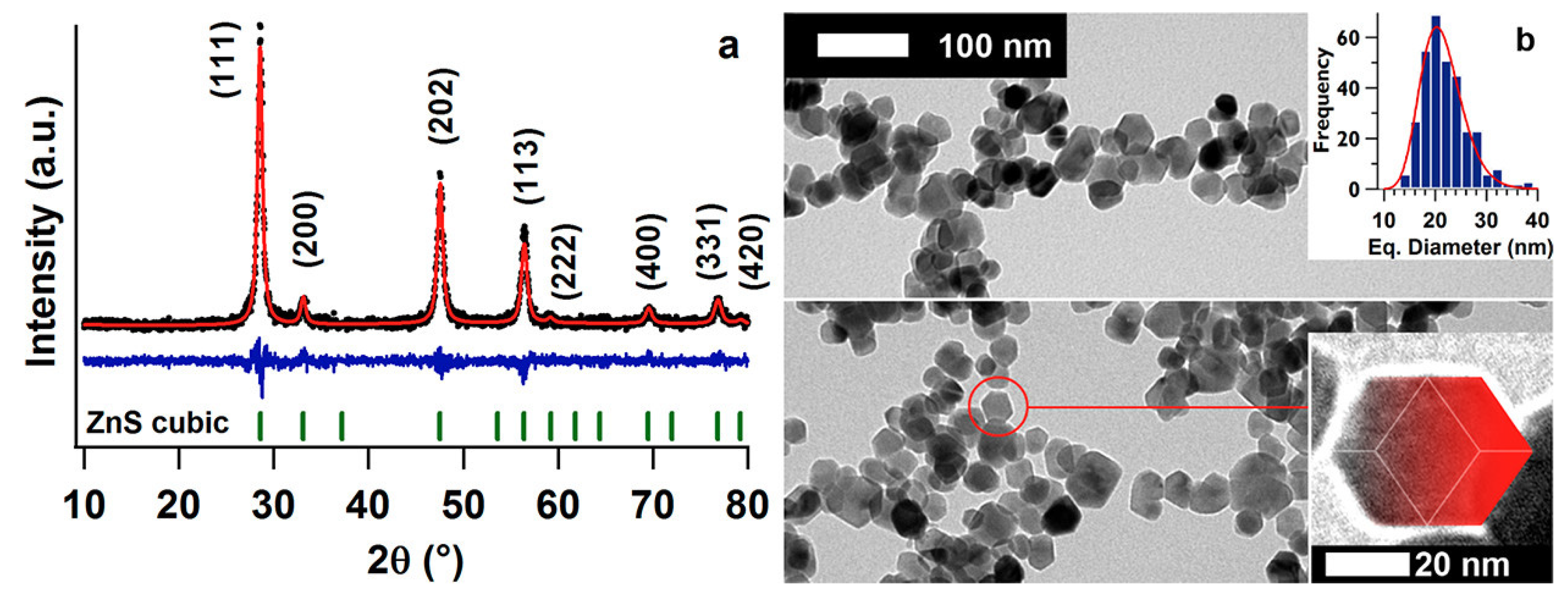

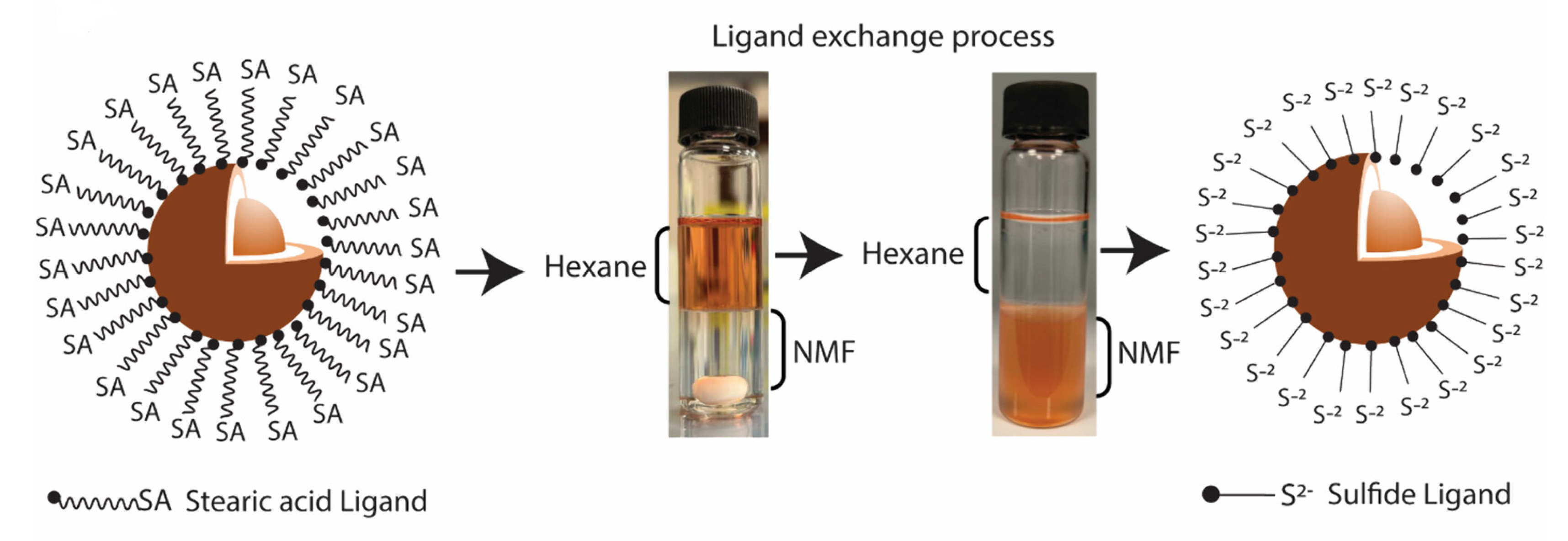
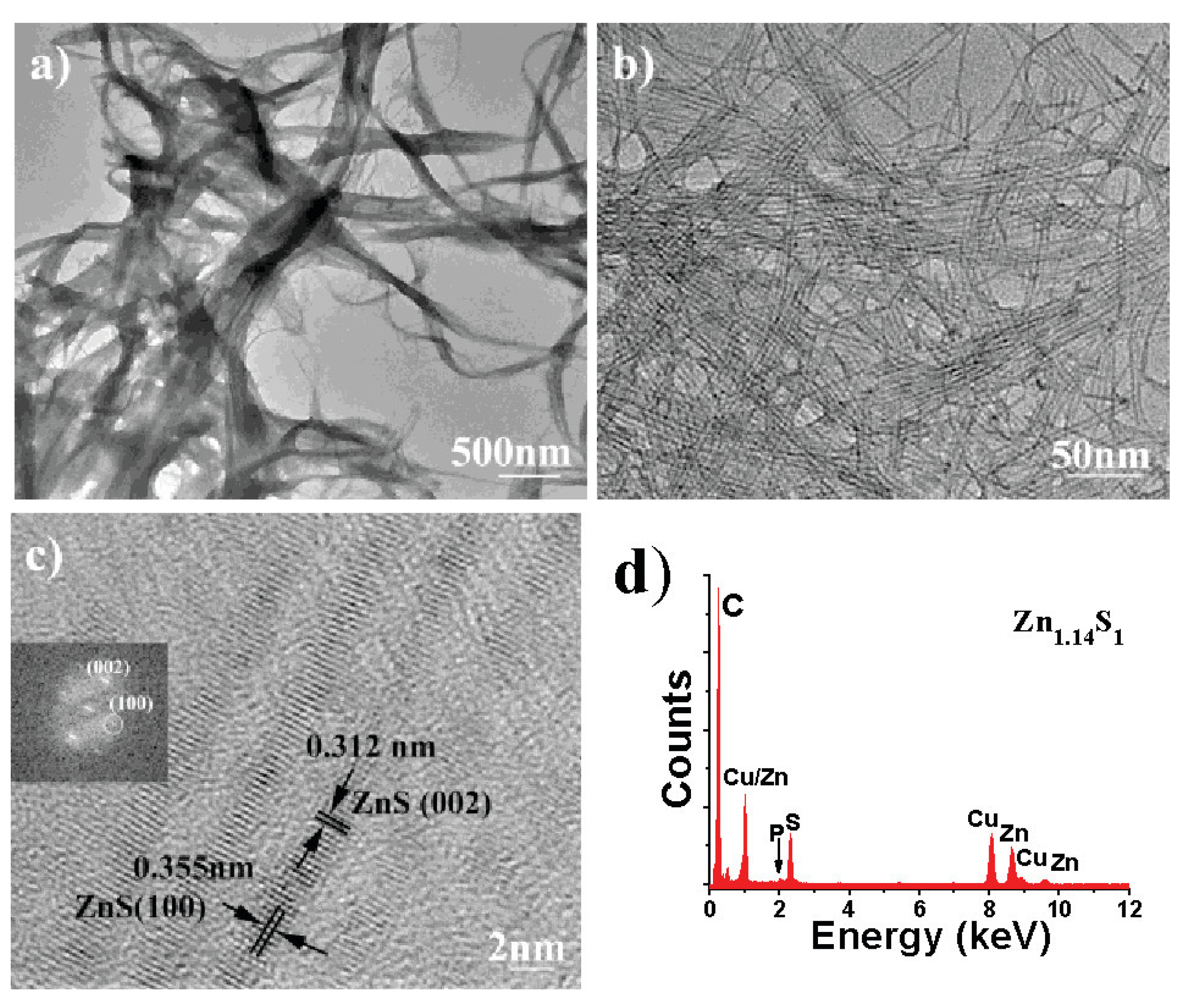
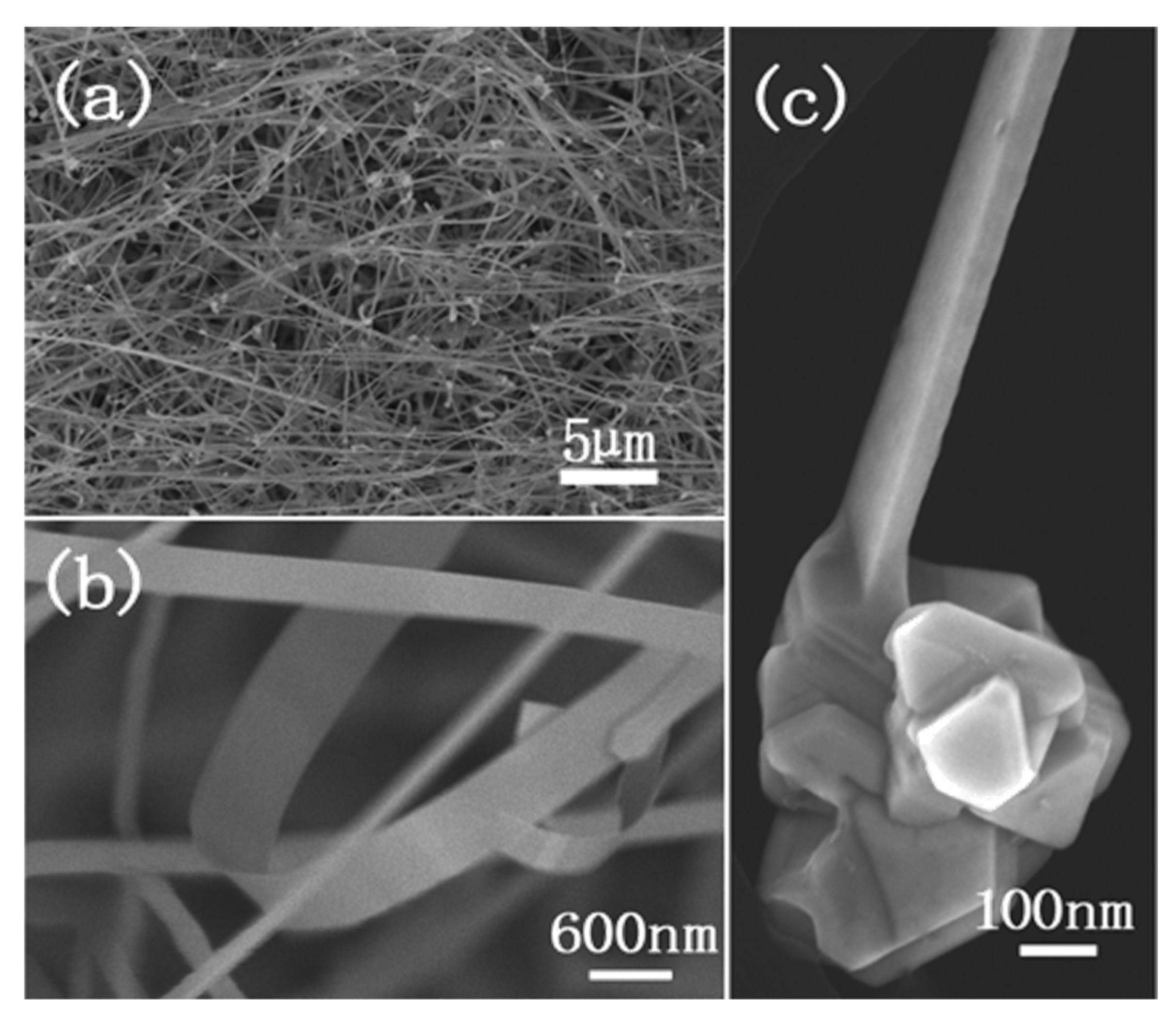
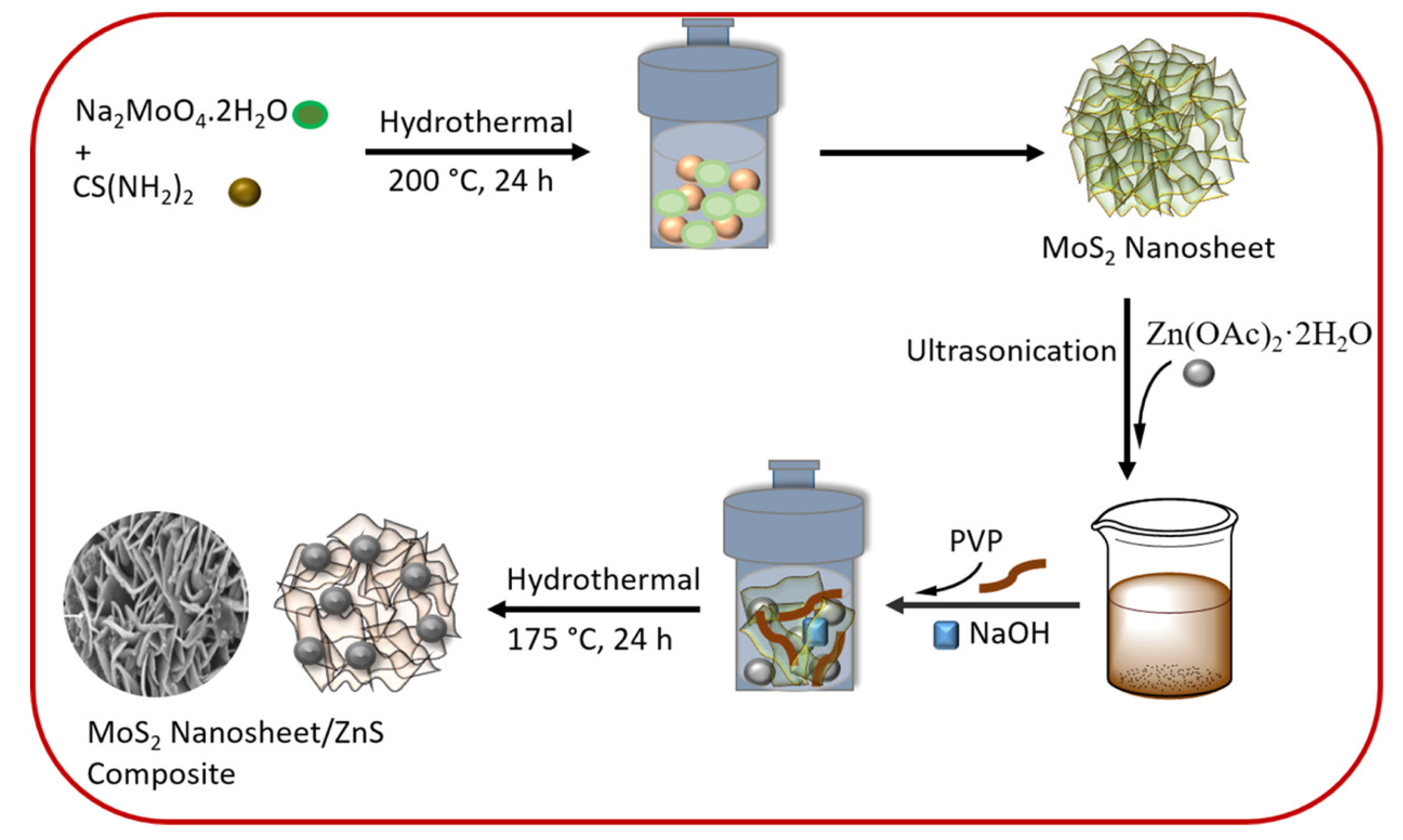


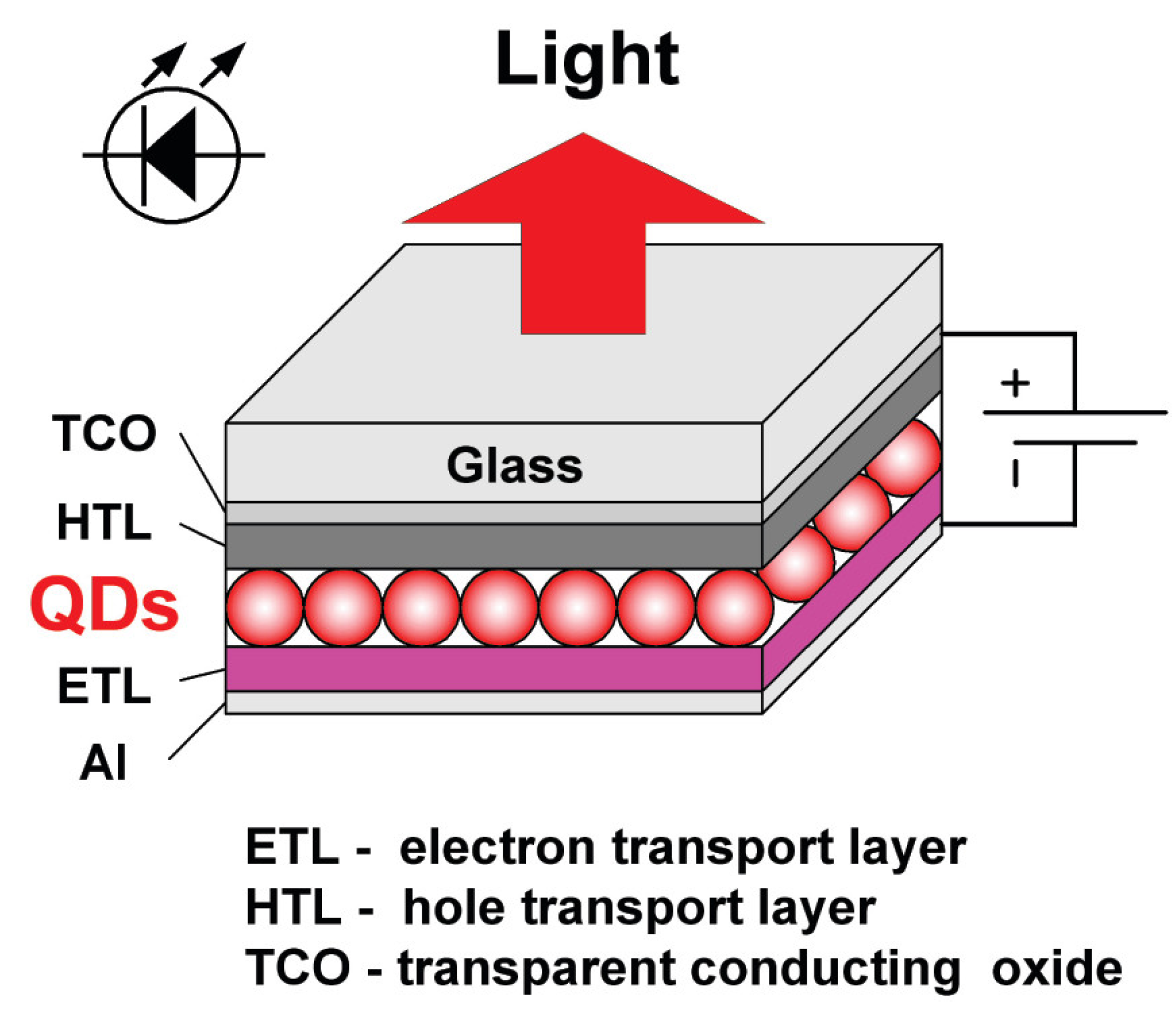
| Zinc Precursor | Sulfur Precursor | Capping Agent | pH | Particle Size/ Crystallite Size (nm) | Method Used to Determine Particle Size | Reference Number |
|---|---|---|---|---|---|---|
| Zinc sulfate | Sodium sulfide | Cysteine | 6 | 2.4 | UV-Vis absorption spectroscopy | [11] |
| Zinc sulfate | Sodium sulfide | Cysteine | 7.6 | 6.08 ± 0.74 | HRTEM | [12] |
| Zinc nitrate | Sodium sulfide | Thioglycolate | 7.6 | >200 nm | Dynamic light scattering | [13] |
| Zinc perchlorate | Hydrogen sulfide (5%) | 1-Thioglycerol | 11 | 1.5 ± 0.2 | XRD | [14] |
| Zinc acetate | Sodium sulfide | 1-Thioglycerol | 8 | 1.8 | HRTEM | [15] |
| Zinc chloride | Sodium sulfide | Mercaptoethanol | 10.2 | 1.4 | HRTEM | [16] |
| Zinc acetate dihydrate | Sodium sulfide | PVP | NR * | 2.45 | XRD | [17] |
| Zinc acetate dihydrate | Sodium sulfide | PVA | NR * | 2.60 | XRD | [17] |
| Zinc acetate dihydrate | Sodium sulfide | PEG-4000 | NR * | 3.25 | XRD | [17] |
| Zinc chloride | Sodium sulfide | PEG-8000 | NR * | 2.8–3.3 | XRD | [18] |
| Zinc chloride | Bis(diallydithiocarbamato) | HDA | NR | 1.98–2.81 | HRTEM | [19] |
| Zinc chloride | Bis(diallydithiocarbamato) | DDA | NR | 2.17–5.49 | HRTEM | [19] |
| Zinc chloride | Bis(diallydithiocarbamato) | ODA | NR | 2.03–3.51 | HRTEM | [19] |
Disclaimer/Publisher’s Note: The statements, opinions and data contained in all publications are solely those of the individual author(s) and contributor(s) and not of MDPI and/or the editor(s). MDPI and/or the editor(s) disclaim responsibility for any injury to people or property resulting from any ideas, methods, instructions or products referred to in the content. |
© 2024 by the authors. Licensee MDPI, Basel, Switzerland. This article is an open access article distributed under the terms and conditions of the Creative Commons Attribution (CC BY) license (https://creativecommons.org/licenses/by/4.0/).
Share and Cite
Chakrabarti, A.; Alessandri, E. Syntheses, Properties, and Applications of ZnS-Based Nanomaterials. Appl. Nano 2024, 5, 116-142. https://doi.org/10.3390/applnano5030010
Chakrabarti A, Alessandri E. Syntheses, Properties, and Applications of ZnS-Based Nanomaterials. Applied Nano. 2024; 5(3):116-142. https://doi.org/10.3390/applnano5030010
Chicago/Turabian StyleChakrabarti, Amartya, and Emily Alessandri. 2024. "Syntheses, Properties, and Applications of ZnS-Based Nanomaterials" Applied Nano 5, no. 3: 116-142. https://doi.org/10.3390/applnano5030010






